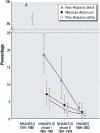Environmental health disparities in housing
- PMID: 21551378
- PMCID: PMC3222490
- DOI: 10.2105/AJPH.2010.300058
Environmental health disparities in housing
Abstract
The physical infrastructure and housing make human interaction possible and provide shelter. How well that infrastructure performs and which groups it serves have important implications for social equity and health. Populations in inadequate housing are more likely to have environmental diseases and injuries. Substantial disparities in housing have remained largely unchanged. Approximately 2.6 million (7.5%) non-Hispanic Blacks and 5.9 million Whites (2.8%) live in substandard housing. Segregation, lack of housing mobility, and homelessness are all associated with adverse health outcomes. Yet the experience with childhood lead poisoning in the United States has shown that housing-related disparities can be reduced. Effective interventions should be implemented to reduce environmental health disparities related to housing.
Figures






Similar articles
-
Housing as a Platform for Health and Equity: Evidence and Future Directions.Am J Public Health. 2019 Oct;109(10):1363-1366. doi: 10.2105/AJPH.2019.305210. Epub 2019 Aug 15. Am J Public Health. 2019. PMID: 31415202 Free PMC article.
-
The economic cost of environmental factors among North Carolina children living in substandard housing.Am J Public Health. 2009 Nov;99 Suppl 3(Suppl 3):S666-74. doi: 10.2105/AJPH.2008.141671. Am J Public Health. 2009. PMID: 19890173 Free PMC article.
-
Housing and health. The role of the environmental health practitioner.J Environ Health. 1982 Nov-Dec;45(3):123-8. J Environ Health. 1982. PMID: 10263348
-
Birth outcome racial disparities: A result of intersecting social and environmental factors.Semin Perinatol. 2017 Oct;41(6):360-366. doi: 10.1053/j.semperi.2017.07.002. Epub 2017 Aug 18. Semin Perinatol. 2017. PMID: 28818300 Free PMC article. Review.
-
Healthy housing: a structured review of published evaluations of US interventions to improve health by modifying housing in the United States, 1990-2001.Am J Public Health. 2003 Sep;93(9):1471-7. doi: 10.2105/ajph.93.9.1471. Am J Public Health. 2003. PMID: 12948965 Free PMC article. Review.
Cited by
-
Study protocol for a randomized controlled trial of Adapt 2 Asthma (A2A), a culturally relevant coping skills and asthma management intervention for Latinx Families.Trials. 2024 Oct 22;25(1):706. doi: 10.1186/s13063-024-08531-w. Trials. 2024. PMID: 39438915 Free PMC article.
-
Evaluation of a Home-Based Environmental and Educational Intervention to Improve Health in Vulnerable Households: Southeastern Pennsylvania Lead and Healthy Homes Program.Int J Environ Res Public Health. 2016 Sep 9;13(9):900. doi: 10.3390/ijerph13090900. Int J Environ Res Public Health. 2016. PMID: 27618087 Free PMC article.
-
Cohort Differences in Mothers' Perceptions of Neighborhood Quality, Child Well-being, and Parental Strain, 1976-2002.Fam Relat. 2018 Oct;67(4):449-466. doi: 10.1111/fare.12327. Epub 2018 Jun 7. Fam Relat. 2018. PMID: 30455537 Free PMC article.
-
Follow-up Post-discharge and Readmission Disparities Among Medicare Fee-for-Service Beneficiaries, 2018.J Gen Intern Med. 2022 Sep;37(12):3020-3028. doi: 10.1007/s11606-022-07488-3. J Gen Intern Med. 2022. PMID: 35355202 Free PMC article.
-
Housing and Health: Here We Go Again.Int J Environ Res Public Health. 2021 Nov 17;18(22):12060. doi: 10.3390/ijerph182212060. Int J Environ Res Public Health. 2021. PMID: 34831815 Free PMC article.
References
-
- Enterprise/Green Communities Green Single Family Rehabilitation Specifications 2008. Columbia MD: Enterprise/Green Communities; Available at: http://www.greencommunitiesonline.org/tools/resources/green_rehab_specs_.... Published 2008. Accessed July 27, 2010
-
- US Department of Health and Human Services The Surgeon General's Call to Action to Promote Healthy Homes. Rockville, MD: US Department of Health and Human Services, Office of the Surgeon General; http://www.surgeongeneral.gov/topics/healthyhomes/calltoactiontopromoteh.... Published 2009. Accessed July 27, 2010
Publication types
MeSH terms
LinkOut - more resources
Full Text Sources
Medical

